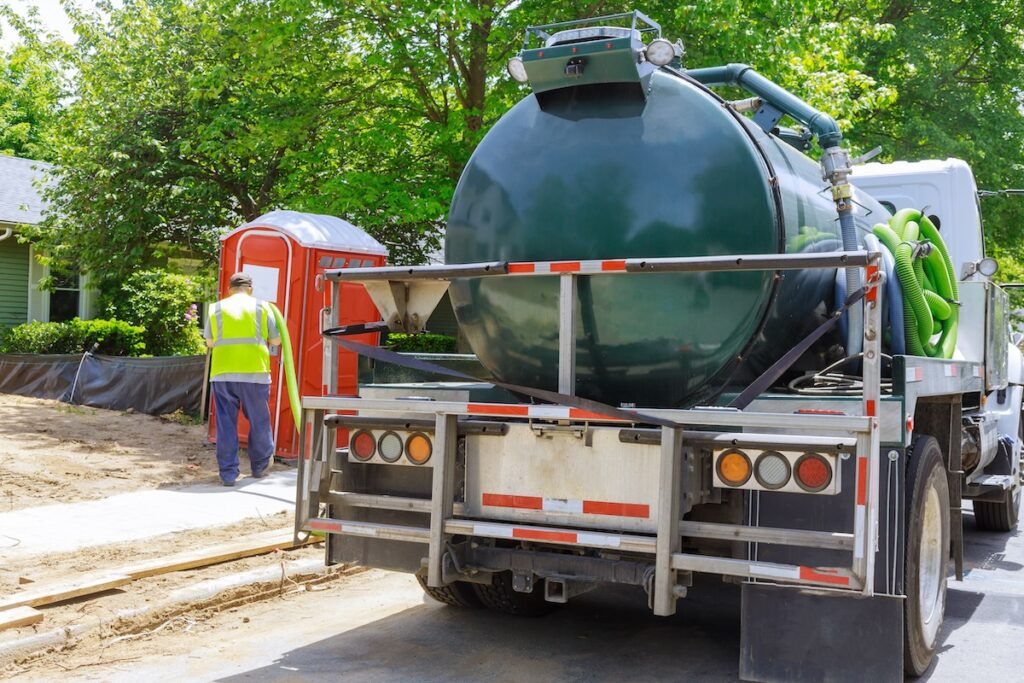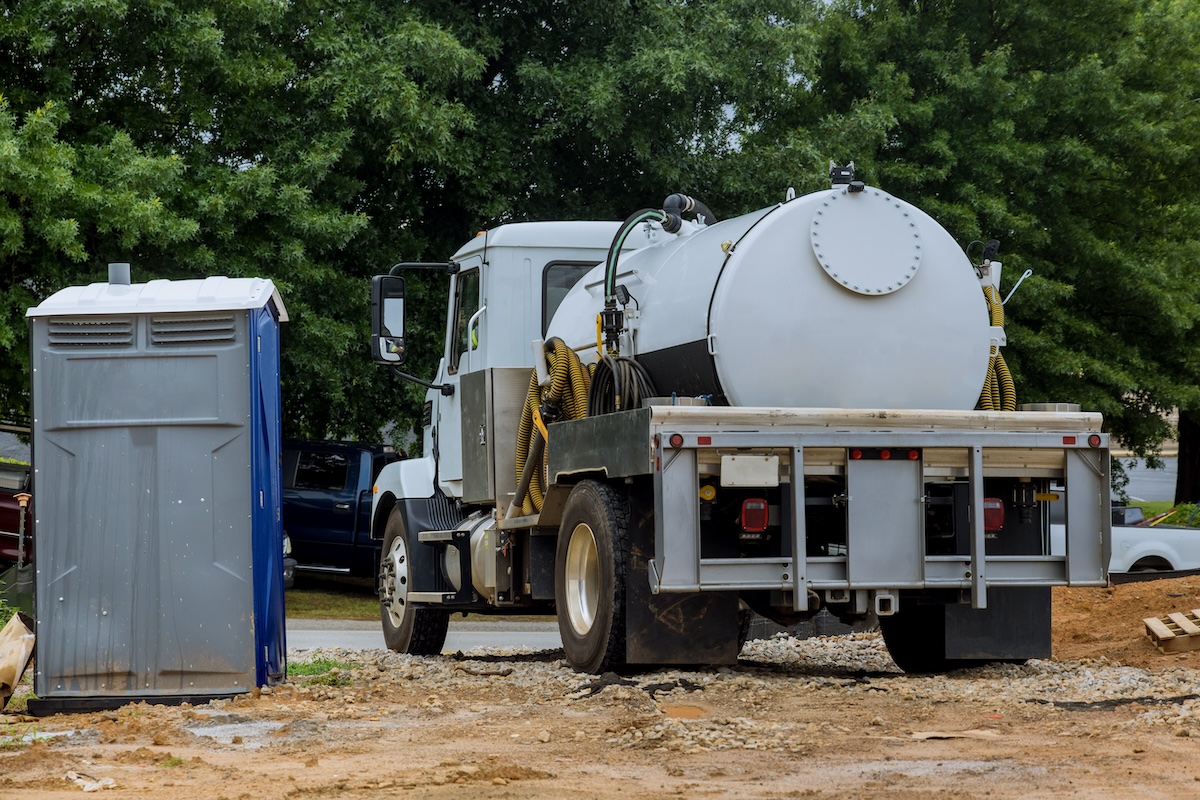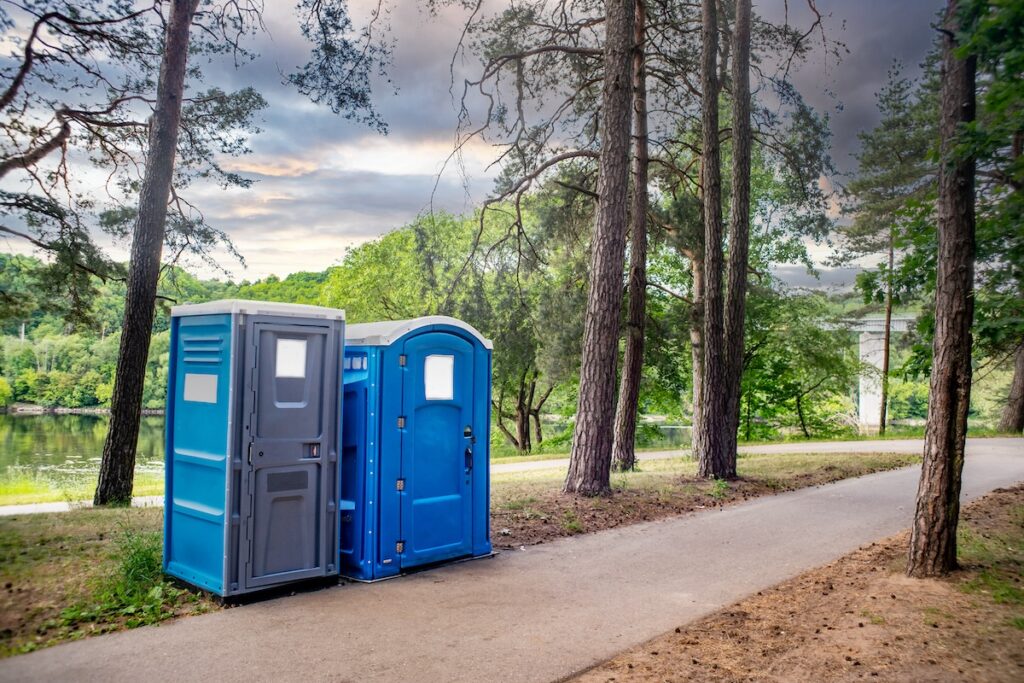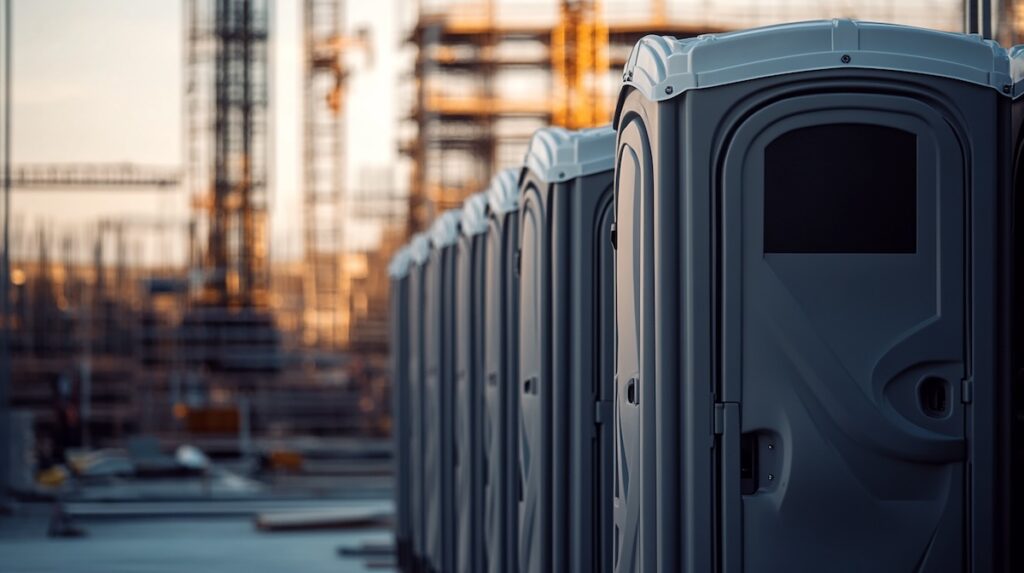The truck pulls up, the hose uncoils, the pump starts its low hum. To anyone passing by, it looks routine—just another stop in the day. The process looks simple from the outside—a hose, a pump, a short stop—but what’s happening inside that tank, and where the waste ends up afterward, is part of a tightly-regulated system most people never think about.
Every portable restroom on a site is a link in a much larger system—one built to collect, move, and treat waste safely. Trucks hum down side roads before sunrise, hoses coil and uncoil, paperwork gets signed in the kind of half-light that only exists at the edge of shift work. There’s coffee balanced on dashboards, radios mumbling, someone double-checking a route because a detour popped up overnight. It’s not especially visible, but it’s steady—a thousand small steps keeping the system running behind the scenes.
In many cases, by the time anyone shows up for work on a construction site or a weekend crowd starts to gather, it’s already been handled by the portable restroom rental provider.
When you see a clean, serviced unit on-site, what you’re really looking at is an entire chain of compliance and care working in the background. The scale behind that mostly-invisible chain surprises most people the first time they learn about it.
What Happens to Portable Restroom Waste After It’s Collected
Note: This overview reflects common practices in the U.S. portable sanitation and wastewater management industry, which operate under environmental regulations such as EPA 40 CFR Part 503 and corresponding state laws.
Step One: Collection

It’s not magic when that service truck pulls up to a row of portable toilets—but it might as well be, considering how few people know what actually happens next.
Inside every portable restroom—whether a standard plastic “porta potty” unit or an upscale, climate-controlled restroom trailer—waste drops into a sealed holding tank.
- Standard units typically use a blue chemical solution to control odor and start breaking down solids
- Higher-end restroom trailers typically use a flush system that collects blackwater in a separate tank for later pumping.
Standard porta potties use a chemical solution (the blue stuff) because they don’t flush—waste falls directly into a small holding tank containing chemical additives. Those additives aren’t only for improving the appearance and smell for guests, they also slow down bacterial growth and start partial decomposition right in the tank, which helps make transportation and treatment cleaner and safer.
Once an event wraps up or a service interval comes due, a technician connects a suction hose from a specialized vacuum truck to the service port at the back of the unit. Pump systems can reach hundreds of gallons per minute, depending on pump size, pulling out liquid and solids together. Modern portable restroom service trucks use a closed-loop suction setup, meaning there’s no open exposure to the operator or the environment—the waste moves directly from the holding tank into a sealed steel container on the truck.

A quick rinse follows, usually with a biodegradable disinfectant, before the tank is refilled with fresh blue solution and water. For construction routes or large-scale events, that service cycle repeats weekly or even daily depending on foot traffic. The goal is consistency; keeping the tanks from ever reaching capacity ensures the units remain hygienic and odor-free.
Step Two: Transportation
Once full, the service truck becomes a mobile transport tank. Regulations require that licensed haulers move and discharge this type of waste, and that each load go to an approved facility: typically either a municipal wastewater treatment plant or a private waste processing site permitted to accept septage. In rural areas in some states, land application of treated septage can still occur under permit.
Drivers typically follow mapped routes similar to those used by commercial septic companies. At the treatment facility, the truck connects to an intake line where the waste is measured, sampled, and logged before being pumped into receiving basins. The paperwork is important: federal and state agencies may require records of every load collected, where it came from, and where it was delivered.
The facility’s intake operator checks the load for pH balance, contaminants, and total solids to ensure it meets the plant’s acceptance standards. Portable restroom waste is largely organic and compatible with typical sewage treatment, so in most municipalities it can be processed right alongside residential wastewater.
It’s not unusual for haulers to maintain relationships with several plants across a service region—one near a construction corridor, another near an event venue area—so disposal stays efficient and compliant. A reputable rental company will be transparent about where its waste goes and how often its fleet disposes of it, which is one of the important trust markers between a provider and a client.

Step Three: Treatment
Once inside the plant, the waste joins the rest of the incoming flow. Mechanical screens remove debris, and the liquid heads into aeration tanks where oxygen and microbes do most of the work. These microbes consume organic matter, converting it into carbon dioxide, water, and stable biomass.
After biological treatment, the clarified water moves through filtration and disinfection—often chlorine or ultraviolet light—before it’s released as treated effluent into local waterways or reused for irrigation in compliance with state environmental standards. The solid material that remains, known as biosolids, is further processed through digestion and drying. Depending on the facility, those biosolids may be used for soil enrichment, sent to landfills, or incinerated.
Portable restroom waste makes up only a small percentage of a treatment plant’s intake, but it follows the same scientifically controlled path as municipal sewage. Every step is monitored for environmental safety, ensuring that the waste from a single weekend event or construction project ends its journey as treated water, not pollution.
Inside the Service Truck
Every step of portable sanitation depends on the truck. These aren’t repurposed septic rigs—they’re purpose-built vacuum systems designed for mobility, containment, and hygiene. Inside the steel tank, internal baffles keep the liquid steady during transport, preventing surge slosh on corners. The suction system itself operates through a high-volume diaphragm or rotary vane pump capable of pulling waste up from several feet below the truck’s intake port.
A secondary rinse tank carries hundreds of gallons of clean water mixed with disinfectant. Once the waste is removed, technicians use that rinse to flush the holding tank, spray interior surfaces, and refill with blue solution. The hoses, fittings, and wand nozzles are pressure-rated and sanitized between jobs. Even small visual cues—the caps, seals, and labeling—are regulated by local health departments.
In the higher-end market, the trucks servicing luxury restroom trailers often run with dual-tank systems: one for blackwater, one for graywater. Graywater, coming from sinks or showers inside a trailer, requires separate handling since it’s less concentrated and can sometimes be discharged under different permits depending on jurisdiction.
What Happens at the Treatment Plant
Once the waste leaves the portable restroom truck, it enters the same infrastructure that handles everything flushed through regular city plumbing. Most loads are delivered to a municipal wastewater treatment plant—facilities built to handle both household sewage and hauled liquid waste.
The truck connects to an intake port called a septage receiving station. From there, the waste is filtered through coarse screens that remove debris before flowing into primary settling tanks. Gravity does most of the first round of work—solids sink, oils and lighter materials rise. The liquid layer in between moves forward for biological treatment.
In aeration tanks, oxygen and specialized bacteria begin breaking down the organic matter. These microbes consume the material, converting it into stable compounds that can safely reenter the environment. The water is then clarified, disinfected, and tested before being released back into rivers or repurposed for irrigation.
The heavier solids—the biosolids—undergo their own process of digestion, drying, and sometimes composting. Depending on the plant and local regulations, they might be used in land applications or taken to controlled landfills.
It’s a precise system designed to keep public waterways clean. Every load that enters the facility is logged, treated, and verified before it ever leaves again.
Why It’s a Regulated Chain

Portable restroom waste is classified as septage under environmental law. That means it’s tracked from the moment it’s pumped out until final treatment. Licensed haulers have to document where each load came from and where it’s disposed. Those records are audited by local or state environmental agencies to ensure nothing is being dumped illegally.
The blue liquid you see in portable restrooms plays a role here too—it’s formulated to be compatible with wastewater treatment so it doesn’t interfere with the plant’s biological processes. Modern formulas are biodegradable and break down naturally under the same conditions as household waste.
If the idea of “tons of portable toilet waste” heading into public systems sounds alarming, it’s not. The volume is tiny compared to a city’s daily flow. For example, one mid-sized treatment plant might process 15–20 million gallons of wastewater per day. Portable restroom waste is a drop in that literal bucket.
So, when you rent a porta potty/portable outdoor toilet, the rental fee is covering more than the unit itself. It’s paying for the disposal infrastructure behind it: Licensed technicians, compliant hauling equipment, treatment facility access, and state-level reporting all factor into that cost. It’s what ensures that the waste doesn’t end up where it shouldn’t.
When people picture a “porta potty truck,” they usually imagine it just drives somewhere to dump the tank. The truth is, there’s no shortcut. Loads must reach an approved destination, get tested, and be processed under the same health and environmental safeguards as household sewage.
That’s why a good provider matters—because in the end, you’re trusting them not just with the restroom, but with what happens after.
Recap: From Tank to Treatment — The Full Journey
The waste from a portable restroom doesn’t vanish into some mystery pit or remote field. It moves through a closed, professional chain designed for safety, compliance, and environmental control:
- ✓ Pumped from the unit into a sealed service truck
- ✓ Hauled by a licensed operator to a wastewater treatment plant
- ✓ Screened, filtered, and biologically treated
- ✓ Converted into clean effluent and stabilized biosolids
From there, the cycle begins again—fresh water is mixed into new sanitizer solutions, clean units are redeployed, and the system keeps running behind the scenes to keep public spaces safe and usable.
What “Sanitized” Typically Means
After pumping, the technician removes traces of waste and typically uses a hospital-grade disinfectant approved by the Environmental Protection Agency for nonporous surfaces. This is not the kind of bleach-heavy cleaner you’d use at home—it’s formulated for biological load reduction, meaning it kills pathogens without corroding plastic interiors or harming the additives that go back in afterward.
Next comes mechanical rinsing. Many units have an internal spray nozzle system that distributes rinse water throughout the holding tank and toilet area. After that rinse, any residual liquid is vacuumed out again, leaving the interior dry before new solution is added.
A final inspection checks hinges, locks, vents, and hand sanitizer dispensers. Everything that touches a user’s hand is wiped down with a separate sanitizing cloth, ensuring cross-contamination doesn’t occur from the operator’s gloves or hose equipment.
What’s often invisible to customers is that every step can be timed. Service logs track the duration between pump-outs, the quantity of blue chemical replenished, and the disposal site’s manifest. Those records matter—if a site inspector or event organizer needs verification, the provider can produce exact documentation.
Environmental Oversight

Portable restroom waste disposal is a logistical matter that’s regulated by multiple layers of environmental law. Haulers must maintain permits for transport, storage, and discharge, renewed annually with proof of disposal site agreements. The EPA and state environmental agencies both set standards for how septage and portable toilet waste must be handled.
For example, in South Carolina and Colorado, state-level environmental management divisions require manifests for loads delivered to a treatment facility. Violations, even paperwork ones, can lead to fines or suspension of hauling privileges. That’s why reputable companies invest in compliance management systems, keeping digital copies of each load’s chain of custody.
There’s also the matter of the chemicals used inside the units. Modern deodorizing agents are non-formaldehyde and biodegradable, breaking down safely during treatment. A good rental provider can specify which formulas they use and whether they comply with current EPA Safer Choice standards.
Colorado Springs and upstate South Carolina both maintain strict disposal oversight, but they naturally operate under completely different regional infrastructures. In Colorado, waste haulers might deliver to municipal plants that process both residential and industrial wastewater, meaning load verification and chemical compatibility checks are done at intake. The terrain and distance between service areas make route planning critical—long hauls eat into service efficiency and fuel costs, so companies with multiple approved dump points can service more units per day without risk of overflow.
In South Carolina, some rural sites may use contracted private facilities or county-managed septage stations. Operators there might deal with local Department of Health and Environmental Control regulations, which dictate how septage can be mixed, stored, or applied to land post-treatment. A single missed step—wrong disposal time, incomplete log—can cost a provider its hauling license.
Why Luxury Restroom Trailers Are Typically Serviced Differently
High-end portable restroom trailers fall under a higher service class for a reason—they use running water, onboard plumbing, and climate-controlled interiors. Waste from these units includes both blackwater and graywater, meaning the disposal process mimics that of an RV or small mobile home.

Technicians connect using sealed couplings similar to those used at RV dump stations, ensuring no exposure to air. Because these units feature multiple fixtures—flushing toilets, sinks, sometimes showers—the tanks fill faster and require more frequent cleaning. The interior itself is treated with non-residual sanitizers to preserve finishes like laminate walls or stainless fixtures.
Clients renting these trailers often expect hotel-grade cleanliness, and that standard is only possible through scheduled service intervals and verified waste disposal routes. For private events or long-term construction headquarters, providers might even assign dedicated technicians to handle routine checks on water supply, pump systems, and HVAC filters.
A System that Keeps Everything Running
Portable sanitation generally works best when it’s invisible. Most guests at an event or crew on a jobsite never see the process, and that’s intentional. Behind the scenes, it’s a coordinated chain of containment, collection, transport, and treatment that operates every day without drawing attention.
The professionalism of that chain—the technicians, the fleet, the facilities—defines the difference between a cheap porta potty rental and a dependable portable restroom partner. It’s the behind-the-scenes part of the service that makes every clean unit possible.
Most clients who rent temporary outdoor toilets, naturally, would never think to ask about disposal logs until a county inspector does—nor should they have to. But a company should be able to produce manifests showing time, location, and treatment facility sign-offs. When you rent portable restrooms, you’re hopefully hiring a team that runs an entire waste handling system in the background, keeping you compliant without ever needing to chase details yourself. There’s relief in working with vendors like that. The job doesn’t require micromanagement, you just know it’s handled.
Sustainability
Modern blue liquids are enzyme-based rather than formaldehyde-based, allowing the organic material to decompose naturally once it reaches the plant. They’re formulated to control odor and bacteria without harming the microbial systems that treatment plants rely on. It’s a small shift that most users would never notice, but for operators, it represents years of reformulating and testing to stay ahead of environmental standards.
Once waste leaves a portable restroom, every part of its journey is controlled under state and federal environmental law. Licensed haulers are required to document when and where they collect, transport, and discharge each load. These records ensure that no waste is dumped illegally and that everything reaches a verified treatment facility.
Each truck is sealed and inspected regularly. The hoses, fittings, and tanks must meet Department of Transportation standards to prevent spills or leaks. Drivers carry route manifests and disposal permits that show exactly which plant or receiving station they’re heading to. It’s a tight system designed to leave nothing to chance.
At the treatment facility, loads are logged again. Operators test the pH balance and solids content before it’s accepted. If anything looks off—wrong color, chemical imbalance, contamination—the facility can reject the load, forcing the hauler to find an approved alternative. That layer of accountability keeps the entire network clean and traceable.
Even the blue deodorizing solution used inside portable restrooms is formulated with this process in mind. Modern blends are biodegradable and fully compatible with wastewater treatment, meaning they break down naturally and don’t interfere with the microbes that clean the water.
In short, the system is built on safeguards that run quietly in the background. The goal isn’t just to move the waste, it’s to move it safely, with every gallon accounted for from start to finish.
Closing the Loop
So where does portable restroom waste actually go? It goes into a system engineered to remove risk—from the unit, to the truck, to the treatment plant, to the environment beyond. Each handoff is designed to keep waste contained, traceable, and harmless by the time it reaches its endpoint.
That process might never make the highlight reel of any event or construction project, but it’s one of the few that keeps everything else possible.
Final Thoughts

Restroom logistics are rarely the first line item anyone thinks about, but they’re among the few that can make or break an experience:
Delays, overflows, or odor complaints can undo weeks of event planning.
On construction sites, they can trigger compliance flags from safety inspectors.
At private parties, weddings, and upscale venues, they shape guest perception more than any sign or decoration ever could.
Integrating waste service schedules into overall planning prevents that. For high-traffic events, that might mean daily pump-outs; for construction projects, it could be twice-weekly rotations tied to crew size. The best porta potty rental companies advise on placement and servicing frequency from the outset, using their route data to forecast demand.
For companies that serve repeat clients—contractors, municipalities, venue operators—consistency matters more than slogans. A clean, well-maintained restroom is a signal of reliability; it shows that the same care is being applied to every other logistical detail on site. The public rarely connects those dots consciously, but they feel the result.
In a way, portable sanitation is a test of integrity. You can’t see most of the work, so clients rely on trust built over time. That trust forms when service happens on schedule, when no one has to make a second call, when the technician on site notices a potential issue before it becomes one. A company that treats those details as routine tends to treat every part of its business the same way.


